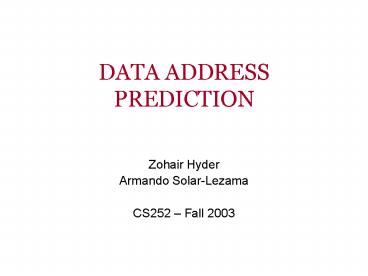DATA ADDRESS PREDICTION - PowerPoint PPT Presentation
1 / 17
Title:
DATA ADDRESS PREDICTION
Description:
Large and increasing gap between ... Higher implies lower load latency ... Higher implies less memory bandwidth needed. Tradeoffs between coverage and accuracy ... – PowerPoint PPT presentation
Number of Views:11
Avg rating:3.0/5.0
Title: DATA ADDRESS PREDICTION
1
DATA ADDRESS PREDICTION
- Zohair Hyder
- Armando Solar-Lezama
- CS252 Fall 2003
2
Motivation
- Large and increasing gap between CPU and memory
speeds - Miss penalty on todays processors over 600
cycles - Load latency is bottleneck on performance
- Solution Prefetch
- Static Compilers may insert prefetch
instructions. Limited because of lack of run-time
information - Dynamic High adaptability
3
Metrics
- Coverage Fraction of DL1 misses that hit in
prefetch buffer - Higher implies lower load latency
- Accuracy Fraction of prefetches that are
actually used by CPU - Higher implies less memory bandwidth needed
- Tradeoffs between coverage and accuracy
- For given memory bandwidth, coverage is probably
more important
4
Architecture
- Prefetch buffer acts as Level 1.5 cache
- Hit time of prefetch buffer is same as DL1
because of small size and same associativity - Demand fetches always get priority over
prefetches - Predictor uses DL1 miss information to determine
prefetches
5
Previous Approaches
- Stream buffers
- Introduced by Jouppi in 1990
- Kessler and Palacharla augmented them in 1994 to
allow filtering and prefetching for non-unit
strides - Reference Prediction Table
- Introduced by Baer and Chen in 1992 to detect
arbitrary strides - Markov Predictor
- Introduced by Joseph and Grunwald in 1999
6
Reference Prediction Table
- RPT indexed by PC of load instruction
- RPT holds last effective address, and offset with
second to last effective address - If current effective address results in same
offset, then prefetch
7
Markov Predictor
- Index by current address table holds 4 possible
next addresses - Issue all 4 into prefetch request queue
- If queue is full, replace an element with lower
priority - LRU prioritization more recently used has higher
priority
8
Strides
- Consider the following statements in a loop
- n k
- u xn
- v yn
- where k is larger than the block size. The miss
address stream will be - A, B, Ak, Bk, A2k, B2k
- Stream buffers perform poorly in interleaved
access streams - RPT works great.
- Markov predictor is incapable of detecting ANY
strides.
9
Our Contributions
- Difference markov predictor
- Use similar markov implementation
- Predict differences rather than addresses
- Input to predictor is current difference, output
is predicted difference - Bayes predictor
- Use 3 inputs current difference, current PC, and
current address - Output is predicted difference
10
Difference Markov Predictor
- Use difference coding
- Index by current difference current address
last address - Predict next difference
11
Difference Markov - Advantages
- Works well with small table size
- Detects strides, even in interleaved access
streams - More compact than RPT, e.g. stride of 1 needs a
single entry - Performs especially well on floating point
applications that are stride-intensive - The Joseph-Grunwald markov predictor is incapable
of predicting any address it has not yet seen - Performs only slightly worse than Joseph-Grunwald
markov on integer applications difference
correlation information can contain address
correlation information too
12
Bayes Predictor
- Predicts based on current PC, current address and
current difference - Use Naïve Bayes method to combine information
from all 3 - Predict next difference
13
Bayes Predictor - Details
- Idea
- For every possible ?n1, calculate P(?n1
?n,PC, Addr) - Predict the ?n1 with highest probability
- If missing data, use the conditional
probabilities given the data we have. - Implementation
- Assume Independence!
- P(?n1 ?n,PC, Addr)P(?n ?n1)P(PC
?n1)P(Addr ?n1)P(?n1) -
P(?n , PC, Addr) - Keep a limited number of the Ps in a table.
- Integer representation
14
Bayes - Advantages
- Works well for small table size
- Performs well on both Floating Point and Integer
applications - Detects most forms of regularity that we have
observed in applications - Has good accuracy across applications
15
Performance For SPEC2000
16
Performance With Table Size
17
Conclusion
- Both our predictors have high coverage for most
applications higher than any other predictor - Bayes predictor generally has best accuracy
across applications - Difference markov has fairly good accuracy too
- Difference markov predictor has great performance
even with small tables, and requires very simple
hardware - Bayes predictor needs more complex hardware































